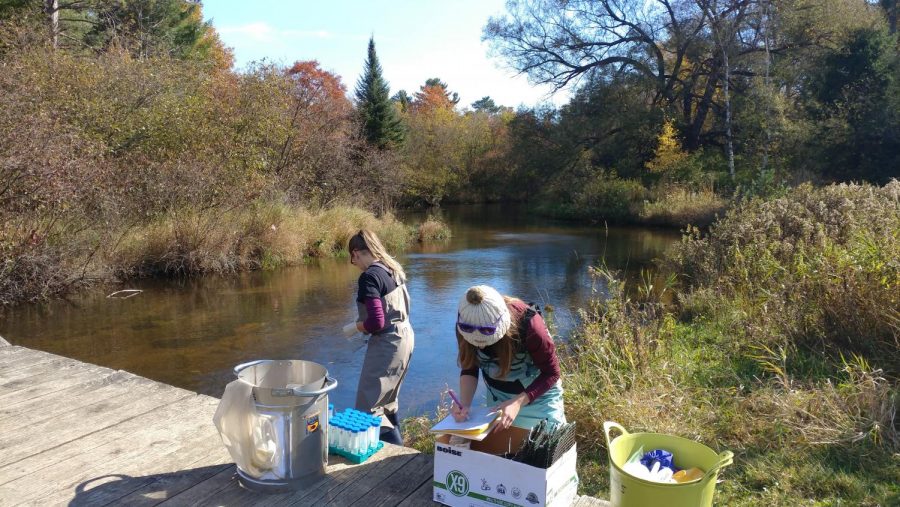OU researchers contribute to ending mudsnail invasions in Michigan waters
Courtesy of Oakland University Aquatic Ecology Lab
Researchers collect samples at a water site to test for the presence of New Zealand mudsnails.
With summer comes fishing, but an invasive species may be lurking if fishers do not take the proper precautions to keep it from spreading.
New Zealand mudsnails are small, invasive aquatic snails that are self-cloning and easily adapt to changing climates, according to the U.S. Fish and Wildlife Service. At just 1/8 inch long, one adult mudsnail can create a colony of 40 million in one year.
Oakland University began researching mudsnail prevalence and prevention in 2016 after receiving funding from the Department of Natural Resources’ Michigan Invasive Species Grant Program, which led researchers to test the species’ prevalence in the Au Sable River in Frederick Township.
Dr. Scott Tiegs, professor and principal investigator of OU’s aquatic ecology lab, said the research team has found up to 100,000 mudsnails in a square meter of water, a density that is likely to have negative consequences for native biota.
“In the Great Lakes region, we have 20 percent of the world’s liquid fresh water, and, unfortunately, this is also one of the world’s hotspots for biological invasions,” Tiegs said. “There are over 180 aquatic invasive species in the Great Lakes that really compromise this amazing natural resource.”
Mudsnail presence can be detected by environmental DNA (eDNA) samples, which detect whether a material’s DNA is present in certain settings. Samples are taken at OU’s research stations or remotely by “citizen scientists” using sample kits and then sent to Dr. Douglas Wendell, biological sciences professor, for testing.
Citizen scientists have been able to play a part in eDNA research through a partnership between OU, Grand Valley State University, Michigan Trout Unlimited and Anglers of the Au Sable. Wendell said eDNA samples from fishers have led to mudsnail detection in new locations.
“One thing eDNA is nice for is with citizen scientists who maybe wouldn’t be equipped to go and do the actual looking for the organism — they’re just out there fishing — they can take a water sample, and if it comes up positive, then Dr. Tiegs’ people can follow up on it,” he said. “It sort of expands our reach beyond where we can get our crews out to.”
The research team emphasized that early detection is the best way to handle mudsnail invasions. After using eDNA to test how many mudsnails exist in a body of water, different measures can be taken to keep infestations from spreading.
Formula 409 was found to be effective in eradicating mudsnails. Anglers can simply spray their waders and other gear with the substance, which can be a simple way to keep mudsnails from moving to unaffected bodies of water.
Further research has discovered New Zealand mudsnails may have an adverse effect on fish. According to research team member and Ph.D. student Jeremy Geist, trout are increasingly ingesting mudsnails, but the snails are passing through their digestive systems and coming out alive, possibly keeping the trout from receiving nutrition.
Mudsnail research is in the developmental phase, as consequences such as their lack of nutritional value are undetermined. Wendell hopes to soon explore the sensitivity of eDNA testing to determine how many need to be present for DNA detection.
With cleaning gear and collecting samples, anglers have been great conservationists and partners in the fight to end the New Zealand mudsnail invasion, according to Tiegs.
“If [anglers] want to continue to enjoy this resource — being fresh water in the Great Lakes — and they want future generations to do that, we have to modify our behavior a little bit,” he said. “And it’s really unfortunate, but that’s the reality that we have now…We need to take more care that we don’t move these around the landscape.”











